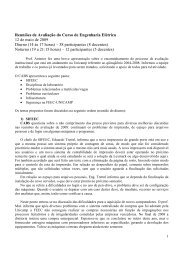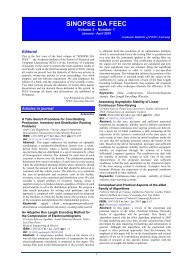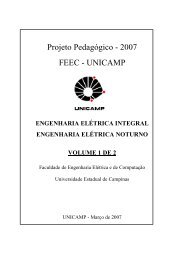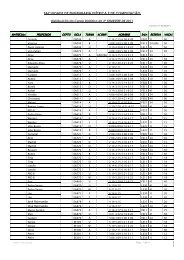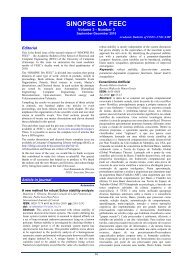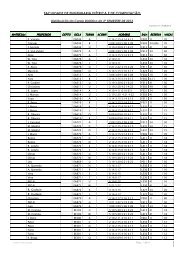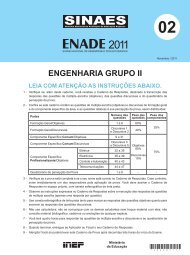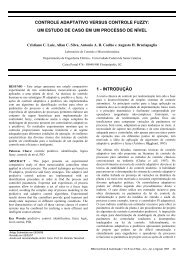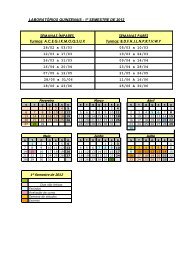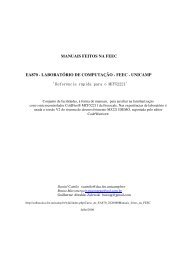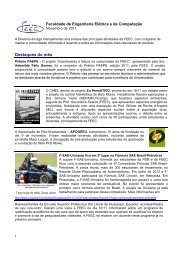Estratégias de Controle para Sistemas de Acionamento com ... - SBA
Estratégias de Controle para Sistemas de Acionamento com ... - SBA
Estratégias de Controle para Sistemas de Acionamento com ... - SBA
You also want an ePaper? Increase the reach of your titles
YUMPU automatically turns print PDFs into web optimized ePapers that Google loves.
ESTRATÉGIAS DE CONTROLE PARA SISTEMAS DE ACIONAMENTO COM<br />
MÁQUINA AssíNCRONA .<br />
Cursino Brandão Jacobina e Antonio Marcus Nogueira Lima<br />
Departamento <strong>de</strong> Engenharia Elétrica, Universida<strong>de</strong> Fe<strong>de</strong>ral da Paraiba<br />
.58109-970 Campina Gran<strong>de</strong>, PB - Brasil, Caixa Postal 1010.5<br />
Fone: 083-:3:331000 R. 442; Fax: 08:3-:3:3:32480;<br />
Email:jacobina(Q!<strong>de</strong>e.ufpb.broumarcus@<strong>de</strong>e.ufpb.br<br />
RESUMO - Este artigo propõe uma classificação <strong>para</strong><br />
as diversas estratégias <strong>de</strong> controle da máquina assíncrona<br />
baseada na escolha das variáveis <strong>de</strong> estado, das variáveis<br />
<strong>de</strong> <strong>com</strong>ando e do sistema <strong>de</strong> eixos <strong>de</strong> referência empregado<br />
na representação da máquina. Nesta classificação<br />
são <strong>de</strong>finidas duas classes <strong>de</strong> estratégias <strong>de</strong> controle <strong>para</strong><br />
a máquina assíncrona: i) controle por escorregamento e ii)<br />
controle em quadratura. A classificação possibilita uma formulação<br />
generalizada <strong>para</strong> a análise das estratégias <strong>de</strong> controle<br />
<strong>de</strong>ste tipo <strong>de</strong> máquina elétrica. A formulação inclui<br />
tanto estratégias já conhecidas quanto estratégias novas,<br />
propostas neste trabalho. As estratégias <strong>de</strong> controle apresentadas<br />
são estudadas e <strong>com</strong><strong>para</strong>das <strong>com</strong> a estratégia<br />
<strong>de</strong> controle <strong>de</strong>nominada <strong>de</strong> controle por orientação pelo<br />
campo. A <strong>com</strong>plexida<strong>de</strong> <strong>com</strong>putacional relativa à implementação<br />
em micro<strong>com</strong>putador das estratégias estudadas<br />
é avaliada. É estudada a influência do tempo morto, relativo<br />
às tarefas <strong>de</strong> aquisição e execução dos controladores,<br />
no <strong>de</strong>sempenho do sistema <strong>de</strong> controle da máquina. As<br />
estratégias <strong>de</strong> controle são estudadas por meio <strong>de</strong> um programa<br />
<strong>de</strong> simulação digital. Também, são apresentados alguns<br />
resultados experimentais selecionados.<br />
Palavras Chaves: Máquina Assíncrona; <strong>Controle</strong> da<br />
Máquina Assíncrona; <strong>Controle</strong> Vetoria!.<br />
ABSTRACT - We may group the control strategies for<br />
the asynchronous machine into two broad classes according<br />
to the state variables, the <strong>com</strong>mand signals and the reference<br />
frame location employed in the machine mo<strong>de</strong>l. These<br />
classes are generically <strong>de</strong>signated by: i) slip control strategies<br />
and ii) quadrature control strategies. This kind of clas-<br />
oArtigo submetido em 28/03/94;<br />
1a Revisão em 12/06/95 2 a Revisão em 24/01/96<br />
Aceito por re<strong>com</strong>endação do Ed.Consultor ProLDr.Edson H.<br />
Watanabe<br />
sification establishes a general framework to the analysis of<br />
the asynchronous machine control strategies. The proposed<br />
approach is quite general and enables one to study both the<br />
classical and novel control strategies. The presented control<br />
strategies are studied and <strong>com</strong>pared to the so-called field<br />
oriented control strategy. This papel' presents some new<br />
strategies and a study of the implementation <strong>com</strong>plexity,<br />
evaluated in terms of the amount of arithmetic operations<br />
involved in each scheme. The study of the closed loop performance<br />
consi<strong>de</strong>ring the effect of the <strong>de</strong>ad time due to the<br />
data input and output and the control <strong>com</strong>putations is also<br />
presented. A <strong>com</strong>puteI' simulation program has been done<br />
and the results are presented and discussed. Some selected<br />
experimental results are presented.<br />
Key-Words: Induction Machine; Induction Machine<br />
Control; Vector Control.<br />
1 INTRODUÇÃO<br />
Os sistemas <strong>de</strong> acionamento estático que empregam<br />
máquinas assíncronas são mecanicamente robustos, mas<br />
sua análise é <strong>com</strong>plexa pois requer o estudo <strong>de</strong> um sistema<br />
multivariável e não linear. Os primeiros esquema.s<br />
<strong>de</strong> acionamentos <strong>com</strong> máquina assíncrona era.m do tipo escalar<br />
e baseados em mo<strong>de</strong>los <strong>de</strong> regime permanente, tal<br />
<strong>com</strong>o o Volts/Hertz (Leonhard, 1985), apresentando fraco<br />
<strong>de</strong>sempenho dinâmico. No intuito <strong>de</strong> <strong>de</strong>senvolver sistemas<br />
<strong>de</strong> acionamento <strong>de</strong> alto <strong>de</strong>sempenho, têm sido investigadas<br />
estratégias <strong>de</strong> controle que assegurem o <strong>de</strong>sacoplamento entre<br />
o controle do fluxo e do conjugado. A utilização <strong>de</strong><br />
técnicas genéricas <strong>de</strong> <strong>de</strong>sacoplamento <strong>de</strong> sistemas, tal <strong>com</strong>o<br />
proposto por Falb e vVolovich (1967), ou baseadas em mo<strong>de</strong>los<br />
escalares, <strong>com</strong>o proposto por Bose (1984), levam em<br />
geral a soluções pouco eficazes e eventualmente <strong>com</strong>plexas.<br />
<strong>SBA</strong> <strong>Controle</strong> &< Automação jVo!.? no. 1jJan., Fev., Mar. e Abril 1996 15
12 CONCLUSÕES<br />
Neste artigo foram classificados e estudados várias estratégias<br />
<strong>de</strong> controle <strong>para</strong> a máquina assíncrona. Estes esquemas<br />
foram classificados em dois grupos: controle por escorregamento<br />
e controle em quadratura. Esta classificação<br />
permitiu a <strong>de</strong>finição <strong>de</strong> algumas estratégias <strong>de</strong> controle novas,<br />
figuras 3 e 6, e contemplou várias estratégias <strong>de</strong> controle.<br />
Os esquemas <strong>de</strong> controle foram estudados por simulação<br />
e alguns resultados experimentais foram apresentados.<br />
Os resultados dos esquemas <strong>de</strong> controle vetorial direto<br />
foram apresentados e <strong>com</strong><strong>para</strong>dos <strong>com</strong> controle por orientaçã,o<br />
pelo campo <strong>com</strong> o fluxo rotórico. A <strong>com</strong>plexida<strong>de</strong><br />
da implementação dos esquemas <strong>de</strong> controle, incluindo o estimador<br />
<strong>de</strong> fluxo, foi discutida. Todos os esquemas <strong>de</strong> controle<br />
direto estudados, apresentaram um <strong>com</strong>portamento<br />
dinámico similar, exceto aquele do controle vetorial por escorregamento<br />
<strong>com</strong> o fluxo estatórico, que possui um tempo<br />
<strong>de</strong> resposta bem superior aos <strong>de</strong>mais. Todavia, este esquema<br />
apresenta uma menor <strong>com</strong>plexida<strong>de</strong> <strong>com</strong>putacional.<br />
Os controladores escalares indiretos apresentaram <strong>de</strong>sempenho<br />
dinámico ruim.<br />
Agra<strong>de</strong>cimentos:<br />
Os autores agra<strong>de</strong>cem ao CNPq o apoio na realização <strong>de</strong>ste<br />
trabalho.<br />
REFERÊNCIAS BIBLIOGRÁFICAS<br />
Blaschke, F. (1971). A new method for the structural<br />
<strong>de</strong>coupling of ac induction machines. Proceedings 2nd<br />
IFAC S'ymp., Dusseldorf, Germany, pp. 1-15.<br />
Bose, B.K. (1984). Scalar <strong>de</strong>coupled control of induction<br />
motor. IEEE Transactions on Industrial Electronics,<br />
Vol. 20, n O l, pp. 216-225.<br />
Broeck, H.W.V., H. Sku<strong>de</strong>lny and G.V. Stanke (1988).<br />
Analysis and realization of a pulsewidth modulator<br />
based on voltage space vectors. IEEE Transactions<br />
on Industry Applications, Vol. 24, n O l, pp. 142-150.<br />
Buhler, H. (1979). Electronique <strong>de</strong> reglage et <strong>de</strong> <strong>com</strong>man<strong>de</strong>.<br />
Presses Polytechnique Roman<strong>de</strong>s - Dunod,<br />
Lausanne, first edition.<br />
Buhler, H. (1983). Reglages echantilonées - Volume 1.<br />
Presses Polytechnique Roman<strong>de</strong>s - Dunod, Lausanne,<br />
first edition.<br />
Chatelain, J. (1983). Machines Eleetriques - Volume 1.<br />
Presses Polytechnique Roman<strong>de</strong>s - Dunod, Lausanne,<br />
first edition.<br />
Doncker, R.W. De and D.W. Novotny (1988). The universal<br />
field oriented controller. Proceedings Industry<br />
Applications S'ociety Annual Meeting, Orleans, USA.<br />
pp. 4.50-456<br />
Falb, P. L. and W.A. Wolovich (1967). Decoupling in the<br />
<strong>de</strong>sign and synthesis of multivariable control systems.<br />
IEEE Transactions on Automatic Control, Vol. 12,<br />
n06, pp. 651-659.<br />
26 <strong>SBA</strong> <strong>Controle</strong> & Automação IVo!.? no. 1/Jan., Fev., Mar. e Abril 1996<br />
Garcia, G.O., R.M. Stephan e E.H. Watanabe (1990).<br />
<strong>Controle</strong> <strong>de</strong> velocida<strong>de</strong> <strong>de</strong> um motor <strong>de</strong> indução através<br />
<strong>de</strong> técnicas <strong>de</strong> campo orientado indireto e escorregamento<br />
controlado. Anais do VIII Congresso Brasileiro<br />
<strong>de</strong> Automática, Belém, Pa, pp. 955-960.<br />
Hahetler, T.G. and D.M. Divan (199l).Control strategies<br />
for direct torque control using discrete pulse modulation.<br />
IEEE Transactions on Industry Applications,<br />
Vol. 27, n05. pp. 89:3-90l.<br />
Ho, E. and P.C. Sen (1988). Decoupling control of induction<br />
motor drives. IEEE Transactions on Industrial<br />
Electronics, Vol. 35, n02, pp. 25:3-262.<br />
Jacobina, C. B., E.B. <strong>de</strong> Souza FI. e E.R.C. da Silva<br />
(1990). Controladores <strong>de</strong> corrente <strong>com</strong> motor <strong>de</strong><br />
indução em campo orientado. Anais do VIII Congresso<br />
Brasileiro <strong>de</strong> Automática, Belém, Pa, pp. 991-996.<br />
Leonhard, W. (1985). Control of Electric DTives. Springer<br />
Verlag, Berlin, first edition.<br />
Lima, A.M.N. (1989). Comman<strong>de</strong> numérique d'une machine<br />
asynchrone. Tese <strong>de</strong> Docteur, lnstitut National<br />
Polytechnique <strong>de</strong> Toulouse, Toulouse, France.<br />
Lipo, T.A. e K.C. Chang (1986). A new approach to<br />
flux and torque-sensing in induction machines. IEEE<br />
Transactions on Industry Applications, Vol. 22, nO 4,<br />
pp. 731-737.<br />
Pietrzak-David, M., B. <strong>de</strong> Fome!, A.M.N. Lima and K.<br />
J elassi (1992). Digital control of an induction motor<br />
drive by stochastic estimator and airgap magnet.ic flux<br />
feedback loop. IEEE Transactions on Power Electronics,<br />
Vol. 7, nO 2, pp. 393-403.<br />
Rossi, R.D.F., B.R. Menezes and S.R. Silva (1994). Vector<br />
control of voltage fed three-phase inverters: Variable<br />
switching regions. Proceedings Power Electronics S'pecialists<br />
Conference, Taipei, Taiwan, pp. 219-224.<br />
Santisteban, .J .A. e R.M. Stephan (1993). Proposal of a<br />
general analytical method for the vector controls of<br />
induction motors. Anais do II Congresso Brasileiro <strong>de</strong><br />
Eletrônica <strong>de</strong> Potência, Uberlándia, Mg, pp. 396-40l.<br />
Silva, K.F. (1991). Estimaçà.o do fluxo magnético em<br />
máquinas assíncronas utilizando o filtro <strong>de</strong> Kahnan,<br />
Dissertaçà.o <strong>de</strong> mestrado, Universida<strong>de</strong> Fe<strong>de</strong>ral da<br />
Paraíba, Campina Gran<strong>de</strong>, Pb.<br />
Silva, S.R. (1994). <strong>Sistemas</strong> elétricos <strong>de</strong> alto <strong>de</strong>sempenho<br />
a velocida<strong>de</strong> variável: estratégias <strong>de</strong> controle<br />
e aplicações. Tese <strong>para</strong> Concurso <strong>de</strong> Professor Titular,<br />
Universida<strong>de</strong> Fe<strong>de</strong>ral <strong>de</strong> Minas Gerais, Belo Horizonte,<br />
Mg.<br />
Souza F!., E.B. <strong>de</strong> (1993). Estim?,çà.o e controle em<br />
acionamentos <strong>com</strong> máquinas assincronas em campo<br />
orientado. Tese <strong>de</strong> doutorado, Universida<strong>de</strong> Fe<strong>de</strong>ral<br />
da Paraíba, Departamento <strong>de</strong> Engenharia Elétrica,<br />
Campina Gran<strong>de</strong>, Pb.<br />
Takahashi, I. and T. Noguchi (1986). A new quick response<br />
and high efficiency control strategy of an induction<br />
motor. IEEE Transaetions on Industry Applications,<br />
Vol. 22 nO 5, pp. 820-827.
Anexo A - Dados das Máquinas Assíncronas<br />
Foram utilizadas as máquina A e B nos estudos experimentais<br />
e por simulaçã.o, respectivamente. Os parámetros<br />
<strong>de</strong>stas máquinas é fornecido nas tabelas seguintes.<br />
Máquina A (experimental)<br />
1, 5HV; 380V/220V; GOH z; F.P. 0,86; P = 2<br />
T" =2,00; 1',. = 3,00: Is = 0.128H;<br />
s<br />
I,. = 0, 128H; 1m = 0, 117H; .l/F = 1,438<br />
:Máquina B (simulação)<br />
1, 1HF; 380V/2201/; 50Hz; P = 2<br />
l' = 5,7930; 1',. = :3,4210; 1, = 0, 38GH; I,. = O, 38GH;<br />
s<br />
1m =°.36:3H; .l = O, 0267N m/NI.c//8 2 ; .l/F = 0,8998<br />
28 <strong>SBA</strong> <strong>Controle</strong> & Automação /Vol.7 no. l/Jan., Fev., Mar. e Abril 1996



